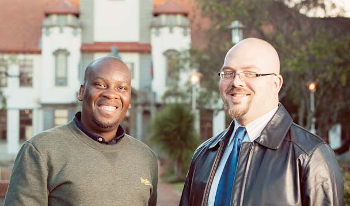A call for next generation of professors: Apply for the Vice-Chancellor’s Prestige Scholars’ Programme
 Examples of the rector's prestige scholars' international footprint: Dr Olihile Sebolai, Fulbright scholar (left) returned to the UFS after six months at the University of Birmingham and three at the University of Missouri. Dr Cilliers van den Berg (right) visited Cornell University on a ten-month sabbatical. |
The Vice-Chancellor’s Prestige Scholars’ Programme (PSP) seeks to identify, develop and promote the next cohort of the most promising and talented UFS academic members of staff who obtained a doctoral degree within the last five years or will graduate by June 2015.
Scholars identified benefit from an intensive programme of academic and professional support that includes an advanced residential programme, exposure to leading scholars, concentrated reading and writing programmes, high-level seminar participation and presentation, nuanced publication schedules and personal mentoring and advice, including participation in the annual PSP mock NRF rating and the development of a postdoctoral intellectual project for funding submission (Thuthuka, and similar).
Past prestige scholars have become Fulbright scholars, received funding from among others the Association of Commonwealth Universities, the Japan Society for the Promotion of Science, Erasmus Mundus, NRF Blue Skies, Thuthuka, etc. They have spent time at universities in Canada, the USA, United Kingdom, Europe and Japan.
This year the selection process will be anticipated by pre-selection. Final selection to the programme will take place in September 2015. The selection is highly competitive, and aimed at those young scholars with the potential to obtain upper-level NRF ratings (Y1 and P).
Criteria for selection:
Recently obtained a PhD degree.
Evidence of an active publication record.
Early recognition of scholarly work, e.g. successful funding/grant applications and academic awards.
The early development of a post-doctoral intellectual project that shows evidence of scholarly “potential” (defined by the NRF Y-category).
Indication of the young scholar’s understanding of what their envisaged postdoctoral endeavours will contribute to the body of disciplinary knowledge.
Full participation in the pre-selection residential programme and activities is a requirement for selection.
Call for interest: 2015 (PDF)
Requests for further information can be directed to Prof Jackie du Toit at dutoitjs@ufs.ac.za.
Applications close on 16 February 2015.